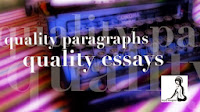 |
| Make your writing as smooth as a swan on a tranquil lake. |
When an essay has order and flow, we say it has coherence. One way to add order and flow to an essay is to use transitional words and phrases.
The transitional words you use in an essay will change depending on the type of essay you're writing; descriptive, narrative, expository, or argumentative.
Using Transitional Words in a Descriptive Essay
The descriptive mode of writing calls for the inclusion of visceral details, details based on the five senses. The ordering of those visceral details is oftentimes the spatial order. This means the details a writer includes in a descriptive essay "move" the reader's attention over the details much like a lens. For example, details can be ordered from left to right across a room, or from top to bottom when describing the way a person dresses or smells, or from focal point to background when describing a painting's texture, or the way a painting makes a writer feel. That means a descriptive essay writer will order the details in much the same way - with a smooth "panning" sensation.
In a descriptive essay, a reader might come across some of the following uses of transitional words and phrases.
- Upon entering
- Stepping across the threshold
- Just as a visitor leaves the museum
- At the top
- Below the
- The most noticeable
Using Transitional Words in a Narrative Essay
The narrative mode of essay writing is reserved for the telling of a true story. When telling a story, a writer uses a chronological order, or time order, to give important details about what happened. Sometimes a writer can use flashbacks or jumps forward in time, but he or she always uses these effects carefully, and uses transitional words and phrases to maintain a flow in the narrative.
In a narrative essay, a reader might come across some of the following uses of transitional words and phrases.
- I ended up in a strange new place with a new name. Little had I known when I woke up that morning seven years ago . . .
- As I got off the train on my way to work
- After lunch
- As the sun was setting
- As we were getting into the car on our way out for dinner
- When she dropped me off after the party
- As I look back, seven years later
Using Transitional Words in an Expository Essay
An expository essay delivers information to the reader, and the genre is very broad. Details can be ordered in many different ways, including the order of importance, categorical order, deductive or inductive order, cause and effect, or process analysis and step-by-step. After a writer chooses the specific order to use in a particular essay, he or she can then choose from a wide variety of transitional words and phrases - some that introduce researched evidence that lends credibility to the information.
In an expository essay, a reader might come across some of the following uses of transitional words and phrases.
- First
- After the bread rises
- More importantly
- Most convincingly
- This leads to
- Therefore
- As (Author, Source) states, " . . . " (Citation).
Using Transitional Words in an Argumentative Essay
The purpose of the argumentative mode, sometimes called the persuasive mode, is to change the way a reader thinks or behaves. A writer achieves this purpose by convincing a reader of the truth and logic in a particular argument he or she is presenting in the essay. That means research sources are often used and must be introduced and cited. Additionally, in order to be convincing, a writer should address more than one side of the argument in the essay. The writer will agree with one side, and will refute, or use information to argue against, another side.
In an argumentative essay, a reader might come across some of the following uses of transitional words and phrases.
- On the other hand
- Additionally
- According to (Author, Source), " . . . " (Citation).
- A study conducted by (Source) helped (Source Author) conclude . . . (Citation).
- In fact
- However
- Furthermore
- Although
- Most convincingly
In Conclusion
No matter which of the four modes of writing a topic requires, the writer must remember to order his or her details appropriately and help the reader follow the order by including transitional words and phrases. These words and phrases will appear not only at the beginning of each new paragraph, but also within the paragraph, between ideas and before source information.
Want to learn more about writing essays?
Copyright Amy Lynn Hess. Contact the author to obtain permission for republication.

.JPG)


No comments:
Post a Comment